Prestoungrange Totems Begin their 6000 Mile Journey
Red Cedars Felled in Chemainus Begin their Journey to Prestoungrange
Its a well kept secret that in August 2006 the Prestoungrange Arts Festival is saying its big 'Thank You' to Chemainus for its inspirational leadership in Murals Arts by raising a totem pole carved in Prestonpans under the leadership of North Cowichan Chemainus First Nations People. As the press cutting from the Ladysmith & Chemainus Chronicle reported however on December 6th, the only trees that will do proper justice to the occasion are North Cowichan's own red cedars. Fortunately the Mayor, Jon Lefebure, had persuaded his Council to donate the trees - all that had to be done therefore was to fell them and get them to Prestonpans. On the map its a 6000 mile straight line more or less going east. Sounds simple and of course it was ... it just looked complex at times!
Click on all images throughout to enlarge
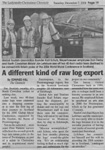
The Famous Red Cedars and Felling Them
The tale began early in November 2004 when the two magnificent red cedars were felled in the forests of Chemainus in North Cowichan by Tim McTiffon under the direction of Forester Darrell Frank. They also attended to their limbing and peeling [which meant they gave up their branches and their bark].
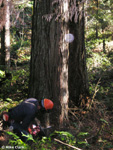 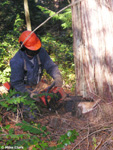 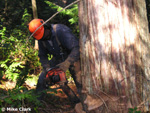 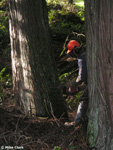
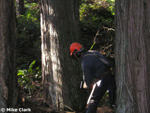 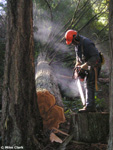 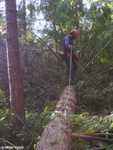
Getting the Cedars out of the Forest
Step 2 was to get the trees from their home forest to a carefully chosen ‘timber yard’ with access for a spacious container, and this was accomplished by one Scotty Thomson, needless to say born Scotland with an accent to prove it. [“No problem. Just let me know where and when you want them.”]
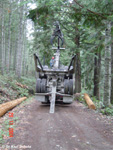 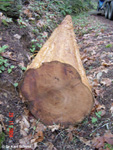
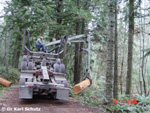 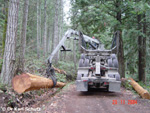 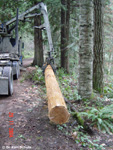
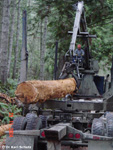 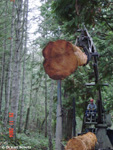 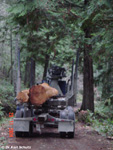
Step 3 involved securing a 40’ container. Tim Strang of Hill’s Native Art in Vancouver who ships finished totems across the world was able to introduce Karl Schutz to Anjali Sadarangani of Wilson Freight. [“No problem shipping 40’ trees to Scotland. Just give me the dates and we look after the rest.] They scheduled November 29th for collection but did have a wee problem and the container arrived a day late. So loading was eventually accomplished, most auspiciously, on St Andrew’s Day.
Weyerhaeuser's SawMill the Ideal Loading Point
Step 4 saw the loading of the trees at the ‘chosen timber yard’, and where better than the world-famous Chemainus ‘sawmill’ that closed in the early 1980s thus creating the challenge that Karl Schutz and others met with their murals programme. Nowadays reopened for business and owned by Weyerhaeuser, it is managed by Jason Kearns, a former neighbour of Karl Schutz who until recently led the Chemainus based Planks Window Factory which was purchased by Weyerhaeuser. Jason Kearns and his colleagues quickly agreed with David Turnbull from the South Island Reman Division that: “Weyerhaeuser would love to handle the loading and if Scotty brought the logs they’d do the forklift truck work, push them in, fasten them down. Nothing to it!” In fact one log was a tad too long but a saw helped it fit the box. Daniel Derby directed three forklifters getting the logs from Scotty Thomson's trailer to the container and safely stowed. [Anne Wills, sister to Prestoungrange was on hand to 'supervise' and ensure fair play - e.g. no log switching.]
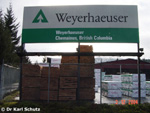 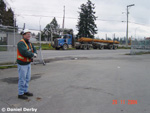 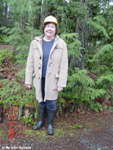
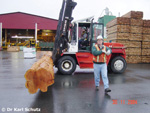 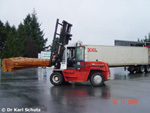 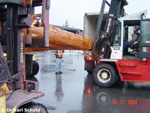

Picture Credits in British Columbia
Many thanks for the above pictures taken by Mike Clark at the felling; Karl Schutz on location with Scotty Thomson throughout; and by Ted Hill of the Ladysmith & Chemainus Chronicle at Weyerhaeuser.
The Tale is Continuing ....
Step 5 of the journey east was to Vancouver then Montreal. For this the container took the night ferry across from Vancouver Island to the mainland where fumigation of the logs was undertaken under Anjali Sadarangani’s direction. Routing by sea in the Pacific then through the Panama Canal had been considered but the more direct route across Canada was eventually selected. So the logs boarded a freight train for Montreal, Quebec, and from there made their passage along the St Lawrence Seaway to the opposite Atlantic coast.
Step 6 is the journey across the Atlantic Ocean to Edinburgh. The vessel selected by Anjali Sadarangani of Wilson Freight Canada was Canmar Pride, Voyage 216E, Reference # 15732130, departing December 9th which then arrives in Europe in time for transfer to a feeder line for the final sea journey to Scotland to be on dockside by December 24th, Christmas Eve. Another auspicious date.
Step 7 is scheduled to take place in the docks in Edinburgh where the trees required Forestry Commission authorization before they could be moved along to Prestonpans. Here Sylvia Burgess, the Baron Sergeand at the Prestoungrange Arts Festival, and Kristine Cunningham take over co-ordination from Karl Schutz and Anne Wills. And once the MasterBill of Lading was to hand Paul Armstrong of Wilson Freight UK began arranging inspection times for Tom Francis of the UK Forestry Commission shortly after Christmas. [Because the trees had been limbed and peeled in the forest, and fumigated in Vancouver, no formal Import Licence was necessary from the Department of Trade and it was anticipated that Forestry Commission protocols had been met.] The relevant Plant Health Order reads:
“Wood of Thuja L., including that which has not kept its round surface, originating in Canada. Without prejudice to Article 3(1) Part A of Schedule 2 and Schedule 3, the wood shall be stripped of its bark and shall be free from grub holes which are larger than 3mm across. Phytosanitary Certificate or Industrial Certificate required to accompany the trees.”
Step 8 follows the trees release from the docks. It involves moving the trees by road from the docks to a temporary resting place in the neighbourhood of Prestonpans as all the other arrangements for their carving come gradually together over the following 12 months.
But watch this NewsNet for more updates .... in the New Year.
Published Date: November 30th 2004
|





